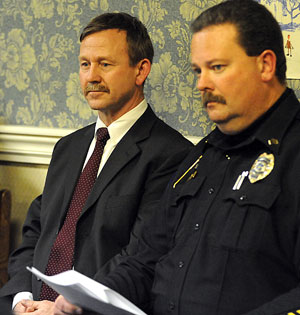
kscarbel2
Moderator-
Posts
18,541 -
Joined
-
Days Won
112
Content Type
Profiles
Forums
Gallery
Events
Blogs
BMT Wiki
Collections
Store
Everything posted by kscarbel2
-
Owner/Driver / September 9, 2015 As the name suggests, trucks and trailers shared centre stage at this year’s Perth Truck and Trailer Show. Held over three days in late July at the Perth Convention and Exhibition Centre, the show attracted local manufacturers, plus local representatives of national companies and eastern states exhibitors keen on promoting their wares in the west. A welcome addition to the 2015 event was the opening day’s information seminars covering topics such as dangerous goods transportation, fatigue management, chain of responsibility (COR) and trailer brake requirements. Cat Trucks’ new triple-rated CT630 HD was displayed prominently at the show. "It’s very comfortable, great visibility, great air-conditioners, and it’s got the yellow engine inside, which is well supported by WesTrac’s footprint up and down the road," business unit manager at WesTrac Kewdale Highway Truck Centre Peter Calligaro says. He says acceptance of the Cat Trucks brand has the biggest hurdle in the west, although that is steadily changing. "Kenworth has been big over here, and Volvo are really doing a big push at the moment, but our product is being accepted now," he says. "It is a good product; I’ve not seen anything that is causing us many headaches, so I believe it’s just to keep pushing, and keep marketing, and we’ll get there in the end." Skipper Trucks had a presence at the show and opted for an outdoors display instead of shouldering arms with competitors inside. Skipper Trucks, part of the Automotive Holdings Group (AHG), has long been a familiar name in the Perth truck market, although close on four years ago it was rebranded as WA Iveco. "Skipper Trucks has been an entity for 30 odd years, and it never actually went away, it just wasn’t a sign on the wall," company representative Mike Rutherford explains. "The last three years, you talk to anyone and they’ll just say: ‘I’m just going down to Skipper’s’. People didn’t change, we were still called Skipper’s." The relaunch of Skipper Trucks has coincided with the move to new premises at Welshpool. Skipper’s showcased two of its premium trucks, an Iveco Powerstar 7800 and an Iveco Stralis 500, at the show to get the Skipper’s name back in the minds of the public. Meanwhile, trailer makers rightly occupied a fair share of space inside the Perth Convention and Exhibition Centre, with local outfits keen to highlight WA’s expertise in that sector. This included Custom Quip Engineering (CQE), which had aluminium tippers on show. Not far from the CQE stand, G & A Lombardi general manager Mike Dunbar chatted with prospective customers about the company’s Steelite end tipper range. Overall, organisers were placed with attending figures with around 8,500 visitors attending over the three days. Show director Peter Woods says while the number of attendees is lower than in previous years, he believes it is due to the industry going through hard times, both locally and across the country. "There has been a definite shift in the industry in the past year or so, and we are grateful to all our exhibitors for sticking with the show and extending their support to the industry," he says. The Perth Truck and Trailer Show is presented by the Commercial Vehicle Industry Association, a division of the Motor Trade Association (MTA). Plans are already underway for the next show, which will be held on July 28 to 30, 2017. Photo gallery - http://www.ownerdriver.com.au/events-news/1509/western-exposure-at-2015-perth-truck-and-trailer-show/
-
Commercial Carrier Journal (CCJ) / September 11, 2015 The “rules of the game” for next-gen engine oils, still set to hit the market late next year, should be fully defined in the coming months, says Chevron Delo’s Shawn Whitacre, giving oil makers like Chevron a year to finalize their products and to meet the new specifications of the so-called PC-11 oils. The new oils are scheduled to be first licensed on Dec. 1, 2016, Whitacre says, the date by which it will be available to fleets and owner-operators. PC-11 will be split into two categories. The first will replace the current CJ-4 oils on the market and will be licenced as CK-4 by the American Petroleum Institute. The second, which will be called FA-4, will be low viscosity oils — “thinner” oils designed to help increase fuel economy and lower greenhouse gas emissions. Whitacre, a senior staff engineer for Chevron, is the new chairman of the ASTM’s Heavy-Duty Engine Oil Classification Panel, replacing outgoing chairman Jim McGeehan, a longtime Chevron oil engineer and longtime chair of the classification development panel. Whitacre has been on the panel since 1996, helping develop five engine oil categories. The two PC-11 oils are the first new classifications in a decade, requested by engine makers several years ago to meet the needs of evolving, modern engines and help aid in meeting current and upcoming fuel economy and emissions regulations. The testing processes for the new categories is stringent and time consuming, Whitacre says — why oil makers like Delo will have a year to conduct the tests on the new oils, which have been in development now for about four years. Oil buyers will, once the products go to market, have more options in their oil choices, Whitacre says, in the form of new lower viscosity grades like 10W-30s or those with even lower viscosity. The CK-4 category will be completely backwards compatible with all engines on the market. But, says Whitacre, the thinner FA-4 oils may not be, and the decisions will be left to the engine manufacturers to determine whether if they can be used in older equipment.
-
Transport Topics / September 14, 2015 Austin, Texas-based FlowBelow Aero Inc. (http://www.flowbelow.com/), a manufacturer of tractor-mounted aerodynamic products, announced it has partnered with tank truck carrier Indian River Transport to equip its tractors with the company’s new fuel saving AeroKit system. No terms of the arrangement were disclosed. The AeroKit includes quick-release wheel covers and a pair of tandem fairings installed on the tractor that work together as a complete aerodynamic system to address the complex airflow around the exposed rear wheels of the tractor. "We have already begun an aggressive installation program with the assistance of FlowBelow at each of our three terminals,” said Mark Gressett, who is safety director at Indian River Transport. Indian River Transport (http://www.indianrivertransport.com/) , which is based in Winter Haven, Florida, operates 650 trucks and 800 food grade tank trailers across the United States, Mexico and Canada. The company primarily hauls fruit juice and dairy products. The patented AeroKit system reduces aerodynamic drag and improves fuel efficiency of the tractor by 2.23% based on SAE J1321 third-party testing using EPA's SmartWay guidelines, the company said. “We tested the AeroKit in our fleet for over seven months, starting in January specifically to test the product’s winter durability and performance,” Gressett said. “There are limited options for improving the aerodynamic performance of a tanker trailer, so we were very interested in the AeroKit as a tractor-mounted aerodynamic system. We were impressed with the product’s durability, ease of use, fuel-efficiency performance of over 3% and investment payback in less than one year.” “Beyond ordering the most aerodynamic and fuel-efficient tractors from the OEMs and controlling driver behavior, routes and fuel stops, there are few options to increase the overall fuel efficiency of a tanker fleet,” said Josh Butler, founder and CEO of FlowBelow. “We are pleased that our Tank Truck AeroKit can play a key role in helping these specialized fleets improve their fuel efficiency and environmental impact.”
-
New Zealand to extradite American on industrial espionage charges
kscarbel2 replied to kscarbel2's topic in Odds and Ends
Obama Administration to Block New Zealand Extradition Request ABC News / September 14, 2015 On Monday, New Zealand Prime Minister John Key announced that the U.S. government was refusing to extradite American truck driver Timothy Maikshilo, who is facing formal charges of industrial espionage. "A document arrived from the United States, rejecting the extradition of Maikshilo, a man who is in the process of causing incalculable damage to New Zealand’s food industry," announced Key, who called the U.S. position "extremely troubling and shocking." According to Wellington Police Chief Tim Barfield, authorities have determined that while Maikshilo was employed in New Zealand as a temporary help truck driver, he took a nighttime position at Sanitarium Health and Wellbeing Company’s factory and headquarters in Auckland as a forklift operator where he took inside information on the manufacture of the company’s Marmite food spread. When he became aware of company suspicion, he abruptly departed New Zealand and returned to the United States. The move by the Obama Administration to block Maikshilo’s extradition has prompted harsh criticism from White House critics who note New Zealand’s long-time support of American policy in the Pacific. U.S. Senator Ted Cruz (R-Texas) calls the decision "a classic and common case of the US exploiting pretenses of law and justice to protect criminals from the rule of law, even when faced with allegations of the most egregious wrongdoing.” Responding to criticism Monday afternoon, U.S. State Department spokesman Patrick Ventrell said "we reiterate our expressions of sympathy to Sanitarium Health and Wellbeing, and understand the potential loss of jobs there. But as a matter of longstanding policy, we don't comment on specific extradition requests, so I simply can't get into that." . -
Missouri mother keeps kids in crate underground Associated Press / September 13, 2015 A 24-year-old mother is in custody Saturday after her two young children were found barefoot, dirty and living in a wooden shipping crate in an underground cave on the eastern edge of Kansas City, Missouri. Brittany Mugrauer was charged Friday night with two counts of felony child endangerment. Jackson County detectives discovered the 4- and 6-year-old children Thursday in the 8-by-10-foot crate furnished with vehicle bench seats, two small blankets, trash and thin wires. According to the probable cause statement, the crate was missing one side and surrounded by car parts and vehicles in various states of disrepair. The investigators, who went to the cave to serve a search warrant related to a possible stolen car operation, noted that the children did not appear frightened by them or the fact that they were alone. The 4-year-old child was using hands to eat a dirty, dry cup of ramen noodles, a detective wrote. When asked why they weren't wearing any shoes, the children responded that they didn't have any. The older child told officers he should be in first grade but did not go to school. The extensive network of caves is the product of massive limestone mining in the late 1800s and early 1900s. Years after the mining operations ceased, companies started finding ways to use the millions of square feet of abandoned underground space. The caves house hundreds of businesses, many of which specialize in storage or warehousing because they are protected from extreme weather and have year-round temperatures of around 70 degrees. The officers were down there investigating a possible chop shop, where stolen vehicles are dismantled so that the parts can be sold or used to repair other stolen vehicles. Many of the caves feature paved roads, utilities and developed business space, while others, such as the one where the children were found, consist of dirt floors and uncontrolled entrances.
-
DAF Press Release / September 11, 2015 The DAF CF Silent has won the Fleet Transport Truck Innovation Award 2016. For the second year in succession, DAF Trucks was honored with this Award, following up on the same decoration last year for the class leading fuel efficient PACCAR MX-11 engine. The jury praises the effective and smart ‘Silent Mode’ solution, contributing to enhanced transport efficiency. The DAF CF Silent is part of the DAF Transport Efficiency program with the aim to further optimize return per kilometer through amongst others enhanced vehicle availability. Thanks to the smart ‘Silent Mode’, the truck enables goods to be loaded and unloaded in areas where evening, night-time or early morning noise restrictions apply. When the special 'Silent Mode' is activated – just by pressing the ‘Silent’ button on the dashboard – the engine software switches to a program that limits torque and engine speed. Gears are changed at lower engine speeds and also thanks to the encapsulation of the gearbox noise level remains even below 72 dB(A). The DAF CF Silent is powered by the Euro-6 DAF MX-11 engine, with ratings of 210 kW/290 hp to 320 kW/440 hp. “Its cleverness and ease of operation made the jury honor the DAF CF Silent with the Fleet Transport Truck Innovation Award,” commented Jarlath Sweeney, Group Editor, Fleet Transport Magazine in Ireland. “The technology makes it possible to continue transport operations during evenings and at night in areas where noise restrictions apply. This directly adds to uptime and thereby increases transport efficiency.” Related photograph - http://www.daf.com/~/media/images/daf%20global/imagebank/daf%20press%20releases/2015/q3/daf%20cf%20silent%20fleet%20transport%20award%202016.jpg
-
Volvo Group Press Release / September 11, 2015 Volvo Group Executive Team member Torbjörn Holmström has announced his intention to step down from his position as Volvo Group Chief Technology Officer and Executive Vice President Group Trucks Technology. A global search will be conducted during autumn 2015 to identify his successor. “After concluding the largest industrial project in history of the Volvo Group - the renewal of the Volvo Trucks and Renault Trucks ranges - it is time to prepare for my successor”, says Torbjörn Holmström, Volvo Group Chief Technology Officer and Executive Vice President Group Trucks Technology. “Continuity in technology leadership is an essential part of driving large product projects and now is a good time to look for a new head of technology development.” Torbjörn Holmström will continue in his current position until such time as a successor has been appointed to lead the Volvo Group´s global truck technology and product development organization. Following this, he will remain at the Volvo Group as senior advisor research and development. .
-
Whether you are working behind the wheel of a truck or a computer screen, sitting down for prolonged period of time is killing you — literally — by way of obesity, heart disease, and diabetes. All this downtime is so unhealthy that it's given birth to a new area of medical study called inactivity physiology, which explores the effects of our increasingly butt-bound, tech-driven lives, as well as a deadly new epidemic researchers have dubbed "sitting disease." "Our bodies have evolved over millions of years to do one thing: move," says James Levine, M.D., Ph.D., of the Mayo Clinic. "As human beings, we evolved to stand upright. For thousands of generations, our environment demanded nearly constant physical activity." But thanks to technological advances, that physically active environment has disappeared. When you sit for an extended period of time, your body starts to shut down at the metabolic level, says Marc Hamilton, Ph.D., associate professor of biomedical sciences at the University of Missouri. When muscles — especially the big ones meant for movement, like those in your legs — are immobile, your circulation slows and you burn fewer calories. Key flab-burning enzymes responsible for breaking down triglycerides (a type of fat) simply start switching off. Sit for a full day and those fat burners plummet by 50 percent, Levine says. In addition, the less you move, the less blood sugar your body uses. Research shows that for every two hours spent sitting down per day, your chance of contracting diabetes increases by 7 percent. Your risk for heart disease goes up, too, because enzymes that keep blood fats in check are inactive. You're also more prone to depression: With less blood flow, fewer feel-good hormones are circulating to your brain. "Sitting is the new smoking," says Anup Kanodia, a physician and researcher at the Center for Personalized Health Care at Ohio State University's Wexner Medical Center. As evidence, he cites an Australian study published in October 2012 in the British Journal of Sports Medicine that compared the two pastimes. Every hour of TV that people watch, presumably while sitting, cuts about 22 minutes from their life span, the study's authors calculated. By contrast, it's estimated that smokers shorten their lives by about 11 minutes per cigarette. How can this happen? Not only is sitting lousy at calorie burning, but it has been shown to suppress the production of an enzyme called lipoprotein lipase, which is essential for turning bad cholesterol into good. Sitting can also lead to insulin resistance and, therefore, trouble metabolizing sugar. All these strikes against it help to explain, at least in part, its association with heart disease and diabetes. Spending the day sitting down also has significant negative effects on your posture and spine health, says Douglas Lentz, a certified strength and conditioning specialist and the director of fitness and wellness for Summit Health in Chambersburg, Pa. "When you sit all day, your hip flexors and hamstrings shorten and tighten, while the muscles that support your spine become weak and stiff," he says. It's no wonder that the incidence of chronic lower-back pain among women has increased threefold since the early 1990s. And even if you exercise, you're not immune. We've become so sedentary that 30 minutes a day at the gym may not do enough to counteract the detrimental effects of eight, nine, or 10 hours of sitting, says Genevieve Healy, Ph.D., a researcher at the Cancer Prevention Research Centre of the University of Queensland in Australia. That's one big reason so many women still struggle with weight, blood sugar, and cholesterol woes despite keeping consistent workout routines. In a recent study, Healy and her colleagues found that regardless of how much moderate to vigorous exercise participants did, those who took more breaks from sitting throughout the day had slimmer waists, lower BMIs (body mass indexes), and healthier blood fat and blood sugar levels than those who sat the most. In an extensive study of 17,000 people, Canadian researchers drew an even more succinct conclusion: The longer you spend sitting each day, the more likely you are to die an early death — no matter how fit you are. So if exercise alone isn't the solution, what is? Fortunately, it's easier than you think to ward off the perils of prolonged parking. Just ramp up your daily non-exercise activity thermogenesis — or NEAT. That's the energy (i.e., calories) you burn doing everything but exercise. In his groundbreaking study on NEAT, the Mayo Clinic's Levine used motion-sensing underwear to track every single step and fidget of 20 people who weren't regular exercisers (half of them were obese; half were not). After 10 days, he found that the lean participants moved an average of 150 minutes more per day than the overweight people did — enough to burn 350 calories, or about one cheeseburger. Fidgeting, standing, and puttering may even keep you off medications and out of the doctor's office. Think of your body as a computer: As long as you're moving the mouse and tapping the keys, all systems are go. But let it idle for a few minutes, and the machine goes into power-conservation mode. Your body is meant to be active, so when you sit and do nothing for too long, it shuts down and burns less energy. Getting consistent activity throughout the day keeps your metabolism humming along in high gear. When you get out of your chair and start moving around, you turn on fat burners. Simply standing up burns three times as many calories as sitting down, according to Levine. And, he adds, "NEAT activity can improve blood flow and increase the amount of serotonin available to the brain, so that your thinking becomes sharper and you'll be less likely to feel depressed." Shake things up throughout the day by interrupting your sedentary stints as often as possible. "Stand up every half hour," says Neville Owen, Ph.D., of the University of Queensland. "If you have to sit for longer than that, take more extended and active breaks and move around for a few minutes before sitting back down." When you're reading e-mail and taking phone calls, do it standing. Walk with colleagues to brainstorm ideas. And consider trading your chair for a large stability ball. "It forces you to engage your muscles, and you're likely to stand up more because you're not melting into a chair," Lentz says. At home, it's simple: Limit TV time to two hours a day or less. Better yet, watch it from a treadmill or exercise bike. Among women, the risk for metabolic syndrome — a constellation of health woes including high blood pressure, high cholesterol, and high blood sugar — shoots up 26 percent for every hour per day they spend watching the tube. Not sure how much of a difference these mini moves will make? Swapping a more active approach for just a few of your daily activities can help stave off the one-to two-pound weight gain most women accumulate every year — and it can keep your metabolism buzzing the way nature intended it to.
-
The COMTRANS int'l commercial vehicle show is held every two years at the Crocus Expo Centre in Moscow. The show is held on the odd number years, alternating with the global IAA commercial vehicle show in Hannover, Germany.
-
House bill would increase Interstate weight limit to 91,000 pounds
kscarbel2 replied to kscarbel2's topic in Trucking News
New bill would permit 91,000-lb. rigs with extra axle Fleet Owner / September 11, 2015 Pointing to productivity and safety benefits, Rep. Reid Ribble (R-WI) announced Thursday that he will introduce legislation to allow 91,000-lb., six-axle tractor-trailers on the federal interstate highway system. The Safe, Flexible and Efficient Trucking Act (Safe Trucking Act) will be offered as an amendment to the surface transportation reauthorization, or highway bill, expected to be taken up in the House Transportation and Infrastructure Committee (T&I) next week. Speaking on a teleconference with members of the news media, Ribble explained the extra axle would distribute the weight load and actually improve braking power, compared to a 5-axle rig at 80,000 pounds. And current infrastructure standards can support 91,000-lb., six-axle loads without additional “rehab costs” to Interstate bridges, based on a “deep dive on the data” in the recently released DOT truck size and weight study. Additionally, he expects an increased weight limit on federal interstate highways would shift some truck traffic away from those state highways where higher limits are currently permitted. “For me, it’s not just about productivity, but it’s the increased safety by having fewer trucks moving more product in a safer manner,” Ribble said. “Our roads are already heavily crowded. This 13% increase in capacity is heavily significant in moving more freight with fewer vehicles. This would also result in reduced fuel costs and CO2 emissions.” He cited the immediate benefits to Wisconsin’s paper mills as an example of improved freight efficiency with heavier trucks. Indeed, the congressman’s remarks were followed by representatives from a variety of industries that contend the truck weight increase would aid global competitiveness. American Forest & Paper Assn. President and CEO Donna Harman, who noted that competitors in Canada and Mexico already benefit from higher truck weight limits, said that the number of truck trips for forest products could be reduced by approximately 1.4 million each year under Ribble’s bill. More specifically, Connie Tipton, president and CEO of the International Dairy Foods Assn., said that a 5,000-truck dairy fleet could serve its 150,000 delivery locations with 500 fewer trucks. James Sembrot, senior director of transportation at Anheuser-Busch InBev, called the Safe Trucking Act “common sense policy that everybody can support,” and explained that his company ships more than a million truckloads of beer and raw materials each year—and many of those trailers are 60% empty due to the current weight restrictions. The 91,000-lb. limit would permit Anheuser-Busch to take 100,000 trucks a year off of the highway. He also estimated the cost of adding a sixth axle would be about $7,400 per trailer. The Coalition for Transportation Productivity (CTP), a group of 200 manufacturers, shippers, carriers and allied associations whose primary aim is to support such legislation, organized the press conference. “Truck travel has grown 22 times faster than road capacity since the federal weight limit was last changed in 1982,” said John Runyan, executive director of CTP. “Recognizing that more than 70 percent of freight must be shipped by truck, we need to confront the highway capacity crunch now if our country is to remain competitive. The Safe Trucking Act safely improves the productivity of truck shipments so we can decrease the truckloads necessary to meet demand and make our entire transportation network more efficient.” That the 6-axle configuration is “bridge-formula compliant” and actually saves money on pavement restoration makes the bill “a game changer,” Runyan added. He also pointed out that the legislation would allow DOT to specify additional safety equipment for any trucks operating at the 91,000-lb. limit. “They have the ability to make this a world-class truck for the movement of heavy goods, if they so choose,” Runyan said. Ribble explained that the bill will be offered as an amendment to the highway bill, noting that T&I Chairman Rep. Bill Shuster prefers the base legislation to be as “clean” as possible to garner bipartisan support. And Ribble conceded his bill will face opposition, both from the rail industry and some highway safety groups. But, he suggested, the 91,000-lb. limit should be more acceptable than previous attempts at a 97,000-lb. limit. The Coalition Against Bigger Trucks has led the opposition on those previous attempts, but those efforts came under scrutiny earlier this year when a New York Times investigation revealed that the rail-backed group was paying law enforcement officers to lobby Washington legislators about potential dangers of longer and heavier trucks. Still, his bill shouldn’t be about trucks vs. rail, Ribble noted. “This is as old as rail is, and they’re going to continue to oppose anything that might affect competition in the marketplace,” Ribble said. “That’s to be expected, but we believe they have a strawman argument, based on how goods and services are moving about the county right now.” Ribble also emphasized that his bill shouldn’t be confused with legislation that would increase twin-trailer length from 28 feet to 33 feet. Such legislation is attached to a pending bill to fund the DOT, and the trailer provision faced vocal opposition from Democrats in both the House and the Senate (where the rider made it out of committee by a single vote). Supporters of the longer trailers have emphasized that the configuration is safe because the combination does not add any weight, while Ribble made the case the heavier trucks are safe because they are not longer, under his bill. “We don’t touch the size of the trucks at all,” Ribble said. “Different groups and different organizations, whether for or against, will make their case as it relates to vehicle size, but I deliberately didn’t address it in this bill because I didn’t want to go down that rabbit trail.” Still, the Coalition for Efficient & Responsible Trucking (CERT)—which backs longer trailers—on Thursday issued a notice to address the “misleading language” of the opposition, who are "doing everything possible to undermine proposals to make freight transportation safer and more efficient.” CERT was responding to a recent CQ Roll Call report ("Ribble Bill Would Add Trucks' Weight to Debate on Length") in which a spokesman for the Advocates for Highway and Auto Safety “conflates” the separate issues of truck length and weight, and contends there’s a “significant overlap” in the membership of CERT and CTP—and “they all want bigger and heavier trucks.” CERT rejected the claim, and said the two organizations do not share any common member companies. And, to complicate matters, a lot of truckers don’t like the idea of heavier trucks, either. The Owner-Operator Independent Drivers Assn. (OOIDA) reiterated its objection Thursday, saying the 91,000-lb. limit doesn’t overcome the problems with 97,000-lb. rigs. OOIDA Executive Vice President Todd Spencer called the proposal “a dumb idea on every level.” OOIDA contends the bill just provides an interim step to the higher limits, and that these limits are to benefit shippers and a just few large carriers. Ribble said the T&I leadership would meet Friday to finalize a schedule for introducing its highway bill, with the tentative plan calling for a Thursday, Sept. 17 date for committee mark-up. -
Bloomberg / September 11, 2015 Daimler AG said it expects demand for trucks and buses in Brazil to plunge as much as 50% this year as the crisis in South America’s largest economy gets worse. The market in Brazil, struggling to overcome a crippling recession, will need one to three years to return to growth, Wolfgang Bernhard, head of Daimler’s commercial-vehicle unit, said at the Hamburg club of business journalists late Sept. 10. “We expect to continue hibernating,” Bernhard said. Industrywide truck sales plunged 44% in the first half of the year, the Stuttgart, Germany-based company said in August. Brazil is one of several markets in which “there’s a strong, very cold headwind,” he said. Brazilian bond and equity markets tumbled Sept. 10 after Standard & Poor’s cut the country’s credit rating to junk with a negative outlook. Daimler already has shrunk its Brazilian workforce by about 3,000 jobs under a two-year reorganization and in August announced reduced working hours at its local truck-making division. The company will invest in new products in Brazil despite the downturn because it sees long-term potential in the country, Bernhard said. Daimler has been able to restore market share despite the crisis, becoming the country’s biggest seller of trucks again, he said. “This may not be a sign of spring, but it shows that our team managed to cope with that difficult environment,” Bernhard said. The company operates two truck- and bus-building plants in Brazil and is setting up a factory to start making passenger cars there next year. It employed about 12,000 people in the Latin American country at the end of 2014.
-
New Zealand Herald / September 13, 2015 In a swiftly moving case, Wellington police are investigating an allegation of industrial espionage within the country’s food industry. The New Zealand Herald understands the case involves allegations that a recent temporary help American truck driver working at night part-time at Sanitarium Health and Wellbeing Company’s factory and headquarters in Auckland as a forklift operator took inside information on the manufacture of the company’s Marmite food spread just before abruptly returning to the United States. Wellington Police Chief Tim Barfield said inquiries began several weeks ago after police were approached by a Sanitarium representative. "Police can confirm that there is an investigation under way but it is in its early stages," he said. “Exercising treaty laws between New Zealand and the United States, we are moving forward to extradite the suspect back to New Zealand for questioning.” American counsel for the man under investigation, Timothy Maikshilo, refused to make any comment to the New Zealand Herald. Marketing Manager Mark Roper of Sanitarium’s New Zealand operation stated "We have a witness who will testify that Maikshilo plans to replicate and produce our Marmite product for retail distribution in the United States.” Roper would not say how long Maikshilo had been with the company or what information he was alleged to have taken. "There's an ongoing police investigation and I'm afraid that I can't comment on it at all other than to agree with the police that there is an investigation ongoing and that's all I can say right now," Roper said. .
-
Man murders three brothers, kills self ABC News / September 13, 2015 Three brothers were shot to death by a man who then killed himself in a rural area of Louisiana outside Baton Rouge early Sunday. The East Baton Rouge Parish Sheriff's Office said the men were found dead in a driveway after an argument broke out at about 12:30 a.m. Sheriff's office spokeswoman Casey Rayborn Hicks said the men were watching football and listening to music at a neighbor's house when they got into an argument over the music. The shooter was identified as Rodney Chemin, 60, and the three brothers as Joseph Allen, 57; Perry Allen, 55 and Mark Allen, 51. The four men were found dead outside Chemin's house.
-
Father murders wife and children, kills self Associated Press / September 12, 2015 A Minnesota father used a shotgun to kill his wife and three children before turning the gun on himself. Brian Short killed his wife, Karen, and their three teenage children in their Greenwood home late Monday or early Tuesday. "All evidence indicates Brian Short killed his family members in their bedrooms before turning the gun on himself," the department said in a news release. Officers found the dead family members Thursday during a welfare check at their home. A co-worker of Brian Short told police they hadn't been heard from in days. The children hadn't reported to school since it resumed on Tuesday. Police found Karen Short, 48, and the three children — Cole, 17, Madison, 15, and Brooklyn, 14 — dead in their bedrooms. Brian Short, 45, was found dead in the home's eight-car garage. The Hennepin County medical examiner ruled Saturday that all five died from shotgun wounds to the head and that only Brian Short's wound was self-inflicted.
-
Mother of two children, 9 and 10, guilty of manslaughter Associated Press / September 12, 2015 A mother has been found guilty of involuntary manslaughter in the deaths of her two children in a Preble County, Ohio house fire earlier this year. Chastity Hall, 35, left her 10-year-old daughter and 9-year-old son alone in the home before they perished in the early morning fire on February 20. The remains of Malea, 10, and Malachi Bradburn, 9, were found later in the home near West Alexandria, near the Indiana line. The Dayton Daily News reports Preble County Judge David Abruzzo found the 36-year-old Hall guilty Friday of two counts each of involuntary manslaughter and child endangering. She faces up to 14 years in prison. The 36-year-old Hall had pleaded not guilty. She did not testify during the bench trial. Hall is free on bond until sentencing. The state will issue its sentencing recommendation in the coming weeks. The fire broke out around 3:45am at their home in the 3400 block of East U.S. 35 while Hall was out drinking at a VFW. She reportedly had tried to find a babysitter but couldn't. Hall returned home around 6:45am and reportedly began screaming 'Where are my babies?' when she saw her driveway full of fire trucks. The siblings were found dead in the basement around 10:45am. The origin of the fire has not been determined. According to the Associated Press, there was an earlier report by a fire official that Malachi had been setting fires. The fire official reportedly noted this when he went to the home to inspect an electrical issue. However, Hall's ex-boyfriend, Arcadio 'Eric' Escobar, 33, who was not the childrens' father, also admitted being on the property the night of the fire. He eventually pleaded guilty to felony trespassing but he was never linked to the fire. He told police he had gone to the house the night of the fire, but had left when he found the front door locked. The children were reportedly asleep when Hall left the premises.
-
Fontaine Fifth Wheels in Fatal Accident Recalled
kscarbel2 replied to kscarbel2's topic in Trucking News
I've never encountered anyone in the US or the global market that felt that way. I know numerous US fleets which have over the years switched from Fontaine to Jost, and they all remain enthusiastic over having done so. Holland of course belongs to Germany's SAF now (since 2006). I never cared for those SAF people. -
Critics push U.S. to help Europe by taking more refugees
kscarbel2 replied to kscarbel2's topic in Odds and Ends
I was expecting this, and many of the points are all too true (though this story only scratches the surface). When one is covertly involved in regime change, one can no longer claim to be “Mr. Clean”. --------------------------------------------------------------------------------- Frustrated migrants blame U.S. for their predicament The Washington Post / September 11, 2015 If he ever got the chance, he’d settle in the United States, Rzgar Abdul said. But for now, he lives in this spare, barracks-style refugee camp, placing much of the blame for his squalid existence on the United States. After all, the Islamic State proliferated when U.S. forces pulled out of an unstable country. And that proliferation forced him to leave his home, said Abdul, 28, who is from the Iraqi city of Kirkuk. “Iraq’s problem is America’s problem,” said Abdul, who said he was a translator for the United States during the Iraq war, making him a target. “This crisis is America’s problem. In Iraq, Syria, all over, the U.S. did not do enough.” From the squalid migrant campgrounds in Hungary to the offices of Europe’s elected officials, many others also saw the swell of migrants crossing borders as evidence of a failed U.S. foreign policy. Even as President Obama declared that the country would extend asylum to 10,000 Syrians, many blamed the United States for the migration crisis that has walloped Europe. In Germany, it is rare that the distant reaches of the political left and right agree on anything. But they do now: The United States is at fault. Sahra Wagenknecht and Dietmar Bartsch, deputy chairpersons of the Left Party in the German Parliament, last week savaged U.S. policy in the Middle East. “Killer gangs, such as the Islamic State, were indirectly supported and without hindrance supplied with money and weapons from countries including those allied with Germany,” the two alleged in a policy paper, referring to early efforts to back rebels fighting the government of Syrian President Bashar al-Assad. Others have argued that the United States did not do enough to back the rebels and remove Assad. “When the Left Party is right, it is right,” Alexander Gauland, deputy chairman of the conservative and populist Alternative for Germany party, said in an interview with the right-wing German weekly Junge Freiheit. “America bears a lot of blame for the flow of refugees.” Officials in the United States call the criticism overblown. The CIA spent $1 billion to fund early efforts to unseat Assad. Others have argued that no one could have foreseen the magnitude of the war in Syria. “It’s too easy to blame the U.S. for these waves of refugees and asylum seekers,” said Stephan Mayer, spokesman for the Christian Social Union, a part of German Chancellor Angela Merkel’s governing coalition. “This isn’t caused by the U.S.” In Britain, the crisis has renewed old arguments about the country’s commitment to the Middle East. In 2013, British Prime Minister David Cameron suffered a major blow when the House of Commons voted against British military action in Syria. The vote helped to deter U.S. intervention in Syria over allegations that Assad’s forces were using chemical weapons. Despite both countries’ strong language against the Islamic State and Assad’s government, U.S. and British commentators have criticized their nations’ policies as wishy-washy. “I think the tone here is, above all, you start something and you fail to pick up the pieces — that’s the story of Iraq,” said Iain Begg, a professor at the London School of Economics who specializes in the political economy of the European Union. “And in Libya, it was, you push out [Moammar] Gaddafi, and then what?” Jebrail Mohamed, 26, thought he knew what happened next when the United States did not use more manpower in Syria. That led to hundreds of thousands of deaths in Syria and the need for Mohamed to leave the city of Aleppo. Then came the crossing into Hungary and eventually being sent to a processing center to wait for a passport. In this countryside camp, Mohamed receives 20 euros a day and takes comfort in walking with friends to the local grocery store, the closest thing to entertainment nearby. “We have no country left,” Mohamed said. “Now all we do is wait for passports to go somewhere. Wait. Wait.” As he spoke, a man walked out of the gate to go to the grocery store. “I’m going to Germany,” he joked. The European Union on Friday delayed until next month its efforts to begin a proposed refugee resettlement program, a reflection of internal disputes over how to deal with the crush of asylum seekers. Advocates of the resettlement plan had hoped the E.U. would find common ground Monday on a formula to place as many as 160,000 migrants among 22 countries. Many officials have cried foul. Denmark plans to reject the plan. Foreign ministers from the Czech Republic, Slovakia, Poland and Hungary issued a joint statement Friday calling for the E.U. to create a “more balanced distribution of finances” as well as a greater role “contributing to the international efforts in resolving the ongoing crisis in Syria and Iraq.” Hungarian Prime Minister Viktor Orban lashed out against the migrants and vowed that tougher law enforcement would begin Tuesday. “They seized railway stations, rejected giving fingerprints, failed to cooperate and are unwilling to go to places where they would get food, water, accommodation and medical care,” Orban said at a news conference Friday. “They rebelled against Hungarian legal order.” Meanwhile, rights groups and others stepped up pressure for improvements at various bottlenecks where conditions are “inhumane,” including a center in southern Hungary where video appeared to show penned migrants scrambling for food thrown by security personnel. -
Trump says he'd deport illegal immigrants as U.S. president
kscarbel2 replied to kscarbel2's topic in Odds and Ends
Why is the US pressing China to take back its undocumented (illegal) immigrants now in the US, but NOT asking Mexico to take back theirs??? http://news.yahoo.com/exclusive-u-china-back-undocumented-immigrants-052018032.html This year, Mexico's former ambassador to the US said there are 30 million undocumented (illegal) Mexican immigrants in the US. The US government says the number is 11 million (which you know is understated), while Florida Senator Marco Rubio says 12 to 13 million (again, less than the actual). Why is the US so active to deport 39,000 Chinese, but give 11 to 30 million Mexicans amnesty ??? Any and all illegal immigrants need to be deported. There are far too many people attempting to abide by our laws and immigrate legally. -
Though Turkish truckmaker BMC is no longer producing on-road civilian market trucks, I thought to share some history on it. UK truckmaker Austin began exporting vehicles to Turkey in 1947, and merged with Morris Motors in 1952 to form British Motor Corporation (BMC). BMC was a large commercial truckmaker in Turkey founded in 1964 as a 26/74 joint venture between British Motor Corporation and Ergun Ozakat. Both Austin and Morris trucks were produced. From the 1980s, BMC produced the “Fatih” medium truck which used Leyland's old G-series cab ("Redline/Bathgate" cab). In 1989, BMC was acquired by Turkish company Çukurova Holding. Under Çukurova’s management, BMC developed its own trucks including the Professional (Profesyonel) series from 1996, buses and the Megastar light truck from 2004. The Professional, featuring a cab designed by Italy's Pininfarina, was updated in 2007. Here is the Pro 938 vocational chassis at IAA 2008 (http://nufabi.de/php/bmc/2008-professional-938ede-8x4-fahrgestell.php). In 2010 at the IAA int'l commercial truck show in Hanover, BMC surprised with the impressive new 26-ton Pro 628 UHB (6x4) and 18-ton UHX (4x2) low-entry-cab chassis for the refuse industry. Power was in the form of a 285 horsepower 6.7-liter Cummins ISB, paired with an Allison 3500 series automatic transmission. The Turkish BMC exported trucks to the UK from 2003 to 2013. Financially challenged, BMC ceased production of civilian commercial trucks in May 2013 when it was seized by the Turkish government. In May 2014, BMC was sold to ES Mali Yatırım ve Danismanlik for 212 million Euros and became BMC Otomotiv Sanayi ve Ticaret A.S. The truckmaker is now focused on the defense business. (http://www.janes.com/article/49323/turkish-mrap-output-ramps-up-idx15d2) Additional photographs: http://www.trucksplanet.com/catalog/model.php?id=93 http://www.trucksplanet.com/catalog/model.php?id=92 http://www.trucksplanet.com/catalog/model.php?id=104 http://www.trucksplanet.com/catalog/model.php?id=94 .
-
Your tax dollars being spent to develop new technology which, if viable, will then be freely handed over to one or more big businesses to profit from.........in return for unspoken compensation. Big business should orchestrate and finance their R&D, not John Q. Taxpayer who won't benefit from it (e.g. receive a discount on electrified vehicles utilizing the technology his taxes financed). How much taxpayer money was used by the EPA in their development of their version of massive exhaust gas recirculation (MEGR), the result which was turned over to Navistar to profit from? You'll never know. Note: MAN and Scania MEGR worked (Euro-5).......the EPA's MEGR system for EPA2010 didn't. Proof that government should stay out of engine design........it isn't their area of expertise.
-
Green Car Congress / September 10, 2015 The US Department of Energy (DOE) has issued a funding opportunity (DE-FOA-0001349 ) announcement for up to $11 million to support projects covering two areas of technical interest. The first is medium- and heavy-duty powertrain electrification; the second is a dual fuel fleet demonstration. DOE anticipates making approximately 2 to 4 awards under this FOA, with the majority of funding going to electrification projects. Area of Interest (AOI) 1: Medium and Heavy Duty Vehicle Powertrain Electrification. The objective of this area of interest is to research, develop, and demonstrate electric-drive powertrain technologies for medium- and heavy-duty Plug-in Hybrid Electric Vehicles (PHEV) and Electric Vehicles (EV) that reduce fuel consumption by at least 50% when compared to an equivalent vehicle with a conventional internal combustion engine powertrain driven on a comparable duty cycle. The developed technology must utilize an electric motor for all or part of the motive power required by the vehicle to meet its duty cycle.The developed technology must be for a Plug-in Hybrid Electric Vehicle (PHEV) or Electric Vehicle (EV).The powertrain control and architecture may be optimized for a typical duty cycle to improve efficiency.The technology development should be flexible to allow cost reductions by scaling and calibrating these powertrains across multiple segments.Projects will consist of three phases: Phase 1: Powertrain development; Phase 2: Powertrain integration into a vehicle; and Phase3:Vehicle demonstration for at least one year but may not exceed two years. DOE is encouraging teaming arrangements which involve an electric transportation technology developer, a vehicle manufacturer, and a fleet operator. Area of Interest (AOI) 2: Dual Fuel Heavy Duty Vehicle Fleet Demonstration. The objective of this AOI is to demonstrate and evaluate the performance and emissions systems of dual fuel heavy-duty vehicles equipped with engines capable of operation using a mixture of diesel fuel and gaseous fuels (natural gas, propane or natural gas derived fuels such as DME). Dual-Fuel engine equipped vehicles are capable of benefits such as: Reduced EmissionsPower and torque characteristics of diesel only operationLower cost operation due to replacing diesel with lower cost fuel alternativesReduced reliance on petroleumThe vehicles and dual fuel technologies shall be compliant with New or Inside Useful Life Environmental Protection Agency (EPA) certification requirements (or California Air Resources Board equivalent – CARB), Federal Motor Vehicle Safety Standards (FMVSS), be commercially available, and not experimental, pre-production, or planned for further development under the project. The vehicles to be demonstrated must be subjected to typical engine operation such as that encountered by public transit buses, fire trucks, heavy-duty on-road commercial work trucks, vocational construction trucks, class 8 long-haul trucks, etc. The vehicles should be capable of efficiency, reliability, power, and performance comparable to conventional fuel only operation and must be compliant with the latest emission standards for current model year vehicles. The vehicles and conversion systems must be produced in the United States. DOE strongly encourages that the applicant teams include members appropriate for the proposed vehicle, fuel and operational situation.
-
Renault Trucks Press Release / September 10, 2015 Renault Trucks will be displaying the new additions to its range of firefighting vehicles during the 122nd French Firefighters’ National Convention, to be held in Agen from 23 to 26 September 2015. Leader on the French market for rescue and firefighting vehicles with a market share of 72.3%, Renault Trucks will be exhibiting a broad selection from its Fire and Rescue offering: vehicles from 2.8 to 32 tonne featuring outstanding maneuverability which enables firefighters to reach the site of emergency situations under all circumstances in urban and rural areas, as well as in hard to access locations. The new features Renault Trucks is offering on this range include new chassis layouts for the Fire Tenders. These free up space along the left and right side members, meeting firefighters’ needs by significantly increasing storage space for their equipment. Visitors will also be able to see the new Renault Trucks K crew cab version, a model available in XL (6 seats) and XXL (8 seats) versions. Finally, Renault Trucks will also be showing a Renault Master Public Transport with a new Euro 6 engine in a four-wheel-drive version. Five vehicles will be on display: - Renault Trucks D Cab 2,1m 4x2 Fire tender - Renault Trucks D Cab 2,1m 4x4 Forest Fire Tender - Renault Trucks D Cab 2,1m 4x4 Rural Fire Tender - Renault Trucks K 6x6 XL crew cab (6 seats) - Renault Master 4x4 Public Transport Vehicles in the Renault Trucks Fire and Rescue range of between 2.8 and 32 t. meet firefighters’ needs wherever they have to operate, whether in urban or rural contexts. The Renault Master, Renault Maxity, Renault Trucks D 2m and 2.1m cab, with their spacious interior volumes and excellent manoeuvrability, are used for rescue operations in urban environments. In its 4x4 version, the D Cab 2.1m can operate in rural or forest environments, backed up when necessary by vehicles from the C and K ranges. Their obstacle clearing capacity, high ground clearance and outstanding pulling power enable them to reach the most hard to access locations. Finally, using the Bodybuilder tool, its services and Internet portal, Renault Trucks provides an exclusive service for bodybuilders, assisting them with the complex electronic parameter setting operations these vehicles require. Photo gallery - http://corporate.renault-trucks.com/en/press-releases/nouveaux-amenagements-de-la-gamme-incendie-de-renault-trucks-au-congres-des-sapeurs-pompiers.html
-
Scania Press Release / September 10, 2015 Each day, fully loaded trucks ply the roads from Scania’s production units in Södertälje, Sweden, to its assembly plant in Zwolle in the Netherlands. In addition to engines, gearboxes and axles, the trucks are also jam-packed with information. This information is transmitted to Scania’s R&D engineers as the basis for innovation and product improvements. “Our aim is to continuously strive for even more efficient vehicles,” says Anders Gustavsson, who heads the Scania Transport Laboratory. The operation could be characterised as a laboratory on wheels to evaluate performance in actual transport conditions. With 40 trucks in operation, including those used for internal transport between production units in Södertälje, loads of information is generated. In order to ensure that data is not exclusively related to the driving patterns of individuals, drivers regularly switch trucks with each other. Uptime is paramount at Scania Transport Laboratory and the trucks are regularly maintained and serviced according to stipulated intervals. “We expect 20 workshop hours for trucks that operate an average of 400,000 kilometres annually,” Gustavsson reports. “That corresponds to an uptime ratio of 98.7 percent.” The information gathered en route finds its way to Scania’s development engineers for careful analyses. Results are subsequently utilised to even further enhance efficiency, enabling customers to maximise their investments in vehicles. “One example is the extended interval between two oil changes. Previously, oil was changed after 40,000 kilometres while we now find it sufficient to change oil after 110,000 kilometres. Another example is adjusted gearchanging that can lower RPMs, which are commonly 1,200–1,300 RPM at 80 km/h, to 1,000 and thereby reduce fuel consumption.” Anders Gustavsson is constantly in search of new ways of improving efficiency. And the driver is, of course, at the centre. “We have a continuous programme to coach each driver on the basis of the information collected.” .
BigMackTrucks.com
BigMackTrucks.com is a support forum for antique, classic and modern Mack Trucks! The forum is owned and maintained by Watt's Truck Center, Inc. an independent, full service Mack dealer. The forums are not affiliated with Mack Trucks, Inc.
Our Vendors and Advertisers
Thank you for your support!
















